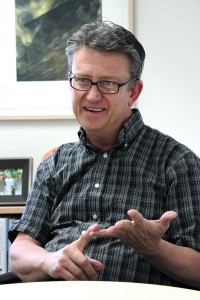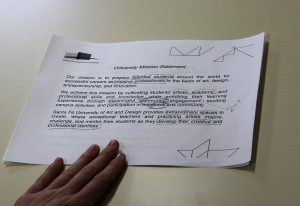Tags
Related Posts
Share This
Mission Possible

Allen Butt, Associate Dean of Academic affairs summarizes SFUAD’s newest mission statement. Photo by Max Matias.
“Mission statements are funny,” says SFUAD’s Associate Dean of Academic Affairs Allen Butt. “The quality can be awful or inspirational or somewhere in between. Very often mission statements are neglected. That happens when not that many people are involved in creating it. On the other side, mission statements can provide a guiding framework for operating a university.”
As the administrator in charge of SFUAD’s self-study, a preparation for New Mexico’s Higher Learning Committee (HLC) evaluations, Butt explains that he recognized a need for a new mission statement when he arrived on campus in January 2013. The old mission statement, Butt explains, was assembled in 2010, when the college re-opened, and it was done in a hurry.
“Now that there’s so much more happening,” Butt says, “we felt that our mission was not accurately captured.” In gathering initial input for the re-draft, Butt explains that he spent a year approaching academic, administrative, housing and maintenance faculty and staff, asking what they thought their mission in the “fabric of the university” was. “The answers,” Butt says, “started to create themes and clusters of ideas” that ultimately lead to the following statement:
Our mission is to prepare talented students around the world for successful careers as creative professionals in the fields of art, design, entrepreneurship, and innovation.
We achieve this mission by cultivating students’ artistic, academic, and professional skills and knowledge, while enriching their learning experience through meaningful community engagement, exciting campus activities, and participation in the global arts community.
Santa Fe University of Art and Design provides extraordinary spaces to create, where exceptional teachers and practicing artists inspire, challenge, and mentor their students as they develop their creative and professional identities.
Following its February approval, SFUAD’s new mission statement will be dispersed throughout campus: dorms, cafeteria, poster, flyers, postcards, the works! The mission’s objectives are important to expose, Butt explains, because it deals with current and future decision-making.
“It’s tricky, this is potentially a very powerful document,” Butt says. “This is what we’re committing to students from now on: professionalism, academics and artistry all in one.” And as an Albuquerque native and prior UNM professor for 20 years , Butt now works to keep the College of Santa Fe’s accreditation record (since 1965) intact in order to keep higher learning in New Mexico. He hopes that by November of 2014, when HLC returns to evaluate, The Santa Fe University of Art and Design can prove to be just as credible and self-determined as a growing art institute.
According to Butt, the statement’s highlights can be summarized threefold: community engagement, professionalism and faculty.
On community engagement, Butt says that a recurring comment among faculty was the idea of community responsibility and social justice. There is a “back and forth exchange of artistic expressions, creative energy and also knowledge,” Butt says. With programs like Outdoor Vision Fest and Artists for Positive Social Change, students can experience more out-of-class and hands-on projects.
However, Film Major Zoe Dahmen disagrees with the mission statement’s community point saying, that she doesn’t feel very attached to the community because “it is very much a fish bowl. It kind of feels separate from everything,” Dahmen says, “especially if you don’t have a car.”
Jacob J. D’Annunzio, contemporary music major and film minor, says he feels that the community aspect of the statement rings true for him. “I think a lot of my positive experiences here have been enriched even more by the student body and who I’ve met and that even applies to professors as well. They’ve really helped cultivate that mission.” D’Annunzio adds that even though SFUAD is a small campus, he feels exposed to many different cultures. “I have a lot of friends from places all over the world. I guess in that way it is like a global community…we’re all working together in the same things.”
In terms of the school’s goals toward professionalism, Butt describes SFUAD’s need to prepare students for future jobs. “In the arts,” Butt says, “it’s been a debate for a long time: Is it fair to give student loans to get an art degree? And of course the answer is yes. In fact, our job placement rate is really high.” According to the administration’s data, within six months 72 percent of graduates get a job within their discipline. And while professionalism may be looked on as “antithetical to the freedom of creating art,” Butt says that the truth is “our artists have jobs” and explains that professionalism, in the context of art, is what is allowing graduates to excel in their fields.
“I think we kind of take business as the hard lessons we learn,” D’Annunzio says. “In film a lot of things are practical. It’s the same with CMP [Contemporary Music Program] majors—playing gigs, forming their own bands, learning the whole side of selling their music. The practicality in a lot of courses here teaches that side of things.”
And while Creative Writing Major Jade Parks believes the statement should be “written in a future tense because it has not been achieved yet,” she adds that the section on exceptional teachers is “one shining moment in this mission statement that is accurate.”
Film Major Dahmen also agrees there are exceptional teachers at SFUAD. “I feel like I do have good mentors here,” Dahmen says, “but I don’t feel like they’re very well appreciated and I think this department relies on adjuncts more than anything. The adjuncts are great, there are some great adjuncts,” she says, but believes the adjuncts should have more pathways toward stable employment.
Regarding faculty, Butt says in the year-long research for the mission statement, he found a huge emphasis on the unique learning experience that students have with their faculty. “We’re just small enough to have personal mentorships. If you’re a big campus that wouldn’t be possible.” According to Butt’s data, the quality of mentorship, working one-on-one with students and helping them discover their creative identities, was a focus of almost every department.

Talented students, global community, extraordinary spaces and developing creative and professional identities. All of this is part of the main purpose of the school. Photo by Max Matias.
“The problem with being a teacher,” Film Major Justin Gaines says, “is that you’re more concerned about getting your numbers correct and making sure the information gets across. That’s it. As a mentor, you have a personal connection. You actually care. As a mentor you have a better chance of figuring out your students’ strengths and weaknesses, then [can] turn their weaknesses into strengths and their strengths into greatness.”
And the power of mentorship, Butt explains, can be further proved in the emotional responses he received from faculty. He asked them to finish the following sentence: “I contribute enriching student’s experience by…”
“If you do that to a faculty member,” Butt says, “and you really get them to start thinking about it, they will be crying in about a minute. What we do as faculty is really personal, we really give up of ourselves. It’s almost a spiritual sharing of interest. The point is not to make them cry but to help them recognize that this mission statement respects their process and what they do.”
So a year’s worth of feedback and 40 revisions later, SFUAD has a new tool for decision-making and whether it’s agreeable to everyone or not, the hope is that it becomes more than a dusty document on the shelf. With such a range of feedback, Butt explains, and a clear goal for SFUAD’s future, he doesn’t think that will happen. “I did not consider myself the author of this document,” he adds, “the campus is the author of this document. Without everyone doing their part, we wouldn’t have a campus.”







 Jackalope Magazine is the student magazine of Santa Fe University of Art and Design. Building on the interdisciplinary nature of our education, we aim to showcase the talent of our university and character of our city.
Jackalope Magazine is the student magazine of Santa Fe University of Art and Design. Building on the interdisciplinary nature of our education, we aim to showcase the talent of our university and character of our city.
Recent Comments